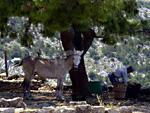| En météorologie marine , la vitesse de pointe d'une rafale s'exprime en mètres par seconde (abr. : m.s - 1 ) ou en noeuds , tandis que l' échelle Beaufort est réservée aux vitesses moyennes . Lorsque la vitesse maximale dépasse de 10 à 15 nœuds la vitesse moyenne, les bulletins de météorologie marine français emploient le terme de rafales ; ils utilisent les expressions fortes rafales lorsque cette différence se situe entre 15 et 25 nœuds et violentes rafales lorsqu'elle dépasse 25 nœuds. En météorologie aéronautique , on parle de rafales quand la vitesse maximale du vent dépasse d'au moins 10 nœuds sa vitesse moyenne. C'est tiré du site de Météo France |
mardi 17 novembre 2009
les rafales
dimanche 15 novembre 2009
le topo météo de Walid
le site tribuglénans étant momentanément en panne, j'installe le cours de Météo de Walid sur ce blog.
mardi 29 septembre 2009
prévoir le Meltem
- Due to the katabatic nature of the meltemi one can experience strong fall winds on the leeward side of the islands, notorious are Kea (we did survive though), Evvia, Tinos and Andros, Folegandros, Kos, Serifos, Amorgos and Sifnos. An orographic cloud to leeward of the mountain spells danger.

- When the wind encounters very high cliffs on the North shore of an island, a calm - extending several miles off shore - can be expected. Good examples are Amorgos, Paros and Naxos.
- In the wide corridor between de dodecanese and cycladic islands the Meltemi blows undisturbed over 100 miles. Within six hours of a 30-knot wind, the waves can reach heights over three meters. The adverse currents make these waves steeper, which can be seriously dangerous for yachts smaller than 10 meter.
- The Ionian Sea in the west of Greece is not affected by these Etesian winds but experiences a reliable Maistro wind throughout the sailing season. For an explanation on the Maistro wind please visit my page on Sailing routes in the Ionian.
- Expect funnelling winds, which can make certain straits dangerous to pass because of currents and higher wind velocities. Classical areas are: between Andros and Evvia (currents up to 5 knots!); between Ikaria and Samos till the Fournoi-archipelago; Between Paros and Naxos; North side of Amorgos; West side of Karpathos. Sometimes South of both Kea and Kythnos.
- Tell-tales for your own Meltemi 24-36 hour prediction:
- Higher predicted atmospheric pressure over the Balkan/Northern Aegean.
- A sudden drop in humidity (first morning without dew on deck).
- Scattered little altocumulus clouds one day in advance.
- A clear improvement of visibility combined with a raise in atmospheric pressure (4 hPa within 12 hours).
samedi 27 juin 2009
dimanche 21 juin 2009
Inscription à :
Articles (Atom)




































